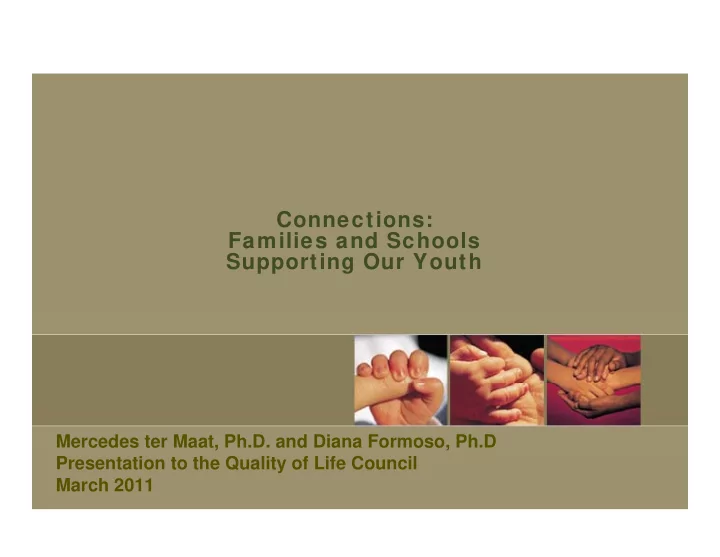

Connections: Families and Schools Families and Schools Supporting Our Youth Mercedes ter Maat, Ph.D. and Diana Formoso, Ph.D Presentation to the Quality of Life Council March 2011
Purpose Purpose of the Study of the Study f th f th St d St d The Connections program is a school-based, family focused intervention developed for low-income, ethnic minority and immigrant children living in South Florida. The purpose of this study was to determine whether the Connections program could enhance the family and school support available to these children, and in this way, bolster their quality of life.
Targeted Protected Targeted Protected Factors and Expected Factors and Expected Outcomes Outcomes It is expected that the Connections program will produce significant, meaningful changes in the targeted protective factors, and in turn, children will exhibit improvements in their academic and mental health outcomes. PROTECTIVE CHILD OUTCOMES FACTORS •Reduced behavior problems •family relationships •Reduced anxiety & •effective discipline CONNECTIONS CONNECTIONS depression depression •coping skills •Increased school •social support engagement & academic •prosocial peers performance
Participants Participants 56 families participated in pre-test interviews, and attendance in the program varied by family (as will be discussed) varied by family (as will be discussed). Due to the focus on program evaluation results, this presentation focuses on the 29 families for whom we have complete data from both pre- and post- 29 families for whom we have complete data from both pre- and post- intervention interviews. 29 mothers or mother figures 29 mothers or mother figures 32 children Children were 3 rd to 5 th graders in our four partner schools Children were 3 to 5 graders in our four partner schools. They ranged from 6 They ranged from 6 to 12 years old ( M = 9.45, SD = 1.35). 66% of participating children were boys. p p g y
Parent Ethnicity Participants Participants
Results Results
Results Results
Results Results FAMILY RELATIONSHIPS • • Mothers reported Mothers reported • being more consistent in their discipline • less harsh parenting (less yelling , name-calling, threatening to spank, threatening to send child away or kick them out of the house) to send child away or kick them out of the house) • Children reported • feeling more accepted by their mothers • less harsh parenting by mothers (less yelling and name-calling)
Results Results YOUTH COPING SKILLS AND SUPPORT SEEKING Children reported Children reported • increased use of emotion-focused coping skills (thinking positively, using distraction and religious coping) • no increased use of problem-focused coping • increase in seeking support from their parents, but not other adults, siblings or peers • increase in asking for help with problem-solving , but not help with feelings
Results Results CHILD MENTAL HEALTH OUTCOMES According to mothers children e hibited According to mothers, children exhibited • decreases in internalizing symptoms (e.g., depression, anxiety, and somatic complaints) • decreases in externalizing symptoms (e.g., rule breaking and aggressive behavior)
Results Results PARENT SATISFACTION WITH INTERVENTION PARENT SATISFACTION WITH INTERVENTION: CUSTOMER SATISFACTION SURVEYS Parents indicated that : •the parenting strategies were very helpful to them. •they learned a lot and their parenting improved. •they felt Connections would be helpful to other parents from their culture or community.
Future Directions: Future Directions: A A Analyses Analyses l l • Families from different ethnic backgrounds responded differently to the intervention. Future analyses will try to understand why this might be the case (e.g., cultural beliefs, exposure to stressors acculturation levels etc ) exposure to stressors, acculturation levels, etc.) • Fathers (n = 8) responded differently to the intervention than mothers. Future analyses, involving statistical techniques appropriate for small sample research, will document results for fathers document results for fathers. • Future analyses will also examine what factors might impact who benefits from the intervention (e.g., exposure to stress, availability of social support, symptom severity before the intervention acculturation) before the intervention, acculturation). • Year 3: We are proposing to interview teachers, parents, and religious leaders to better understand the family lives of immigrant families.
Future Directions: Future Directions: Program Program • To identify sources of grant funding to conduct a wider scale evaluation of the program • • To identify community partners that might be interested in implementing such services To identify community partners that might be interested in implementing such services in their work with low-income, immigrant families from Latin America, Haiti, and the English Speaking Caribbean • • To write papers I(e g To write papers I(e.g., using interviews with families at pre-test to address the risk and using interviews with families at pre test to address the risk and protective factors that might impact low-income Latino and Haitian children; share proven intervention strategies that school counselors can implement in diverse schools). • To provide additional training to professionals and NSU students on culturally competent, evidence-based interventions for ethnically diverse families in South Florida
Thank You! Thank You! Thank you for your generous support of the Connections project! Thank you for your generous support of the Connections project! Questions?
Recommend
More recommend